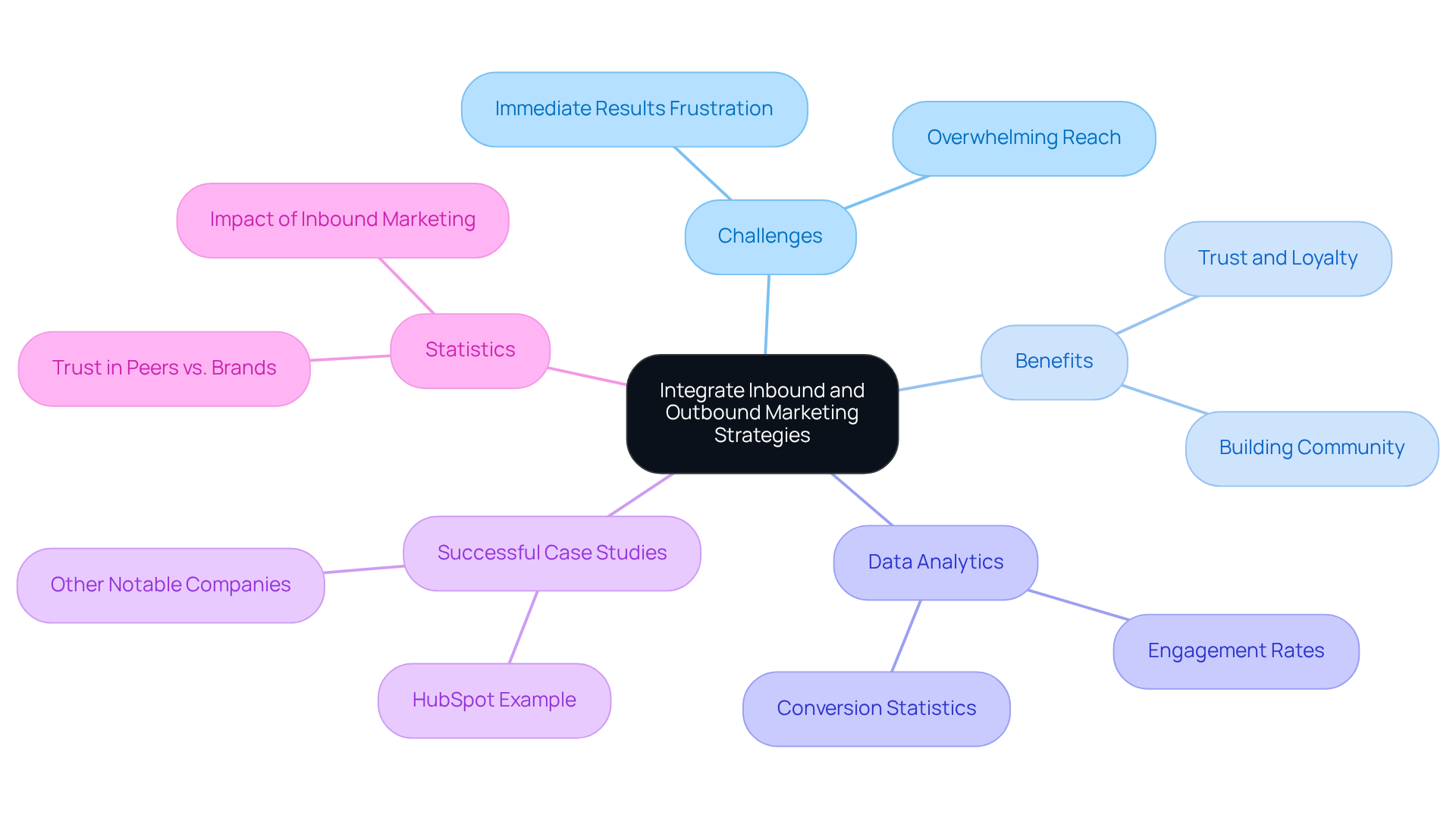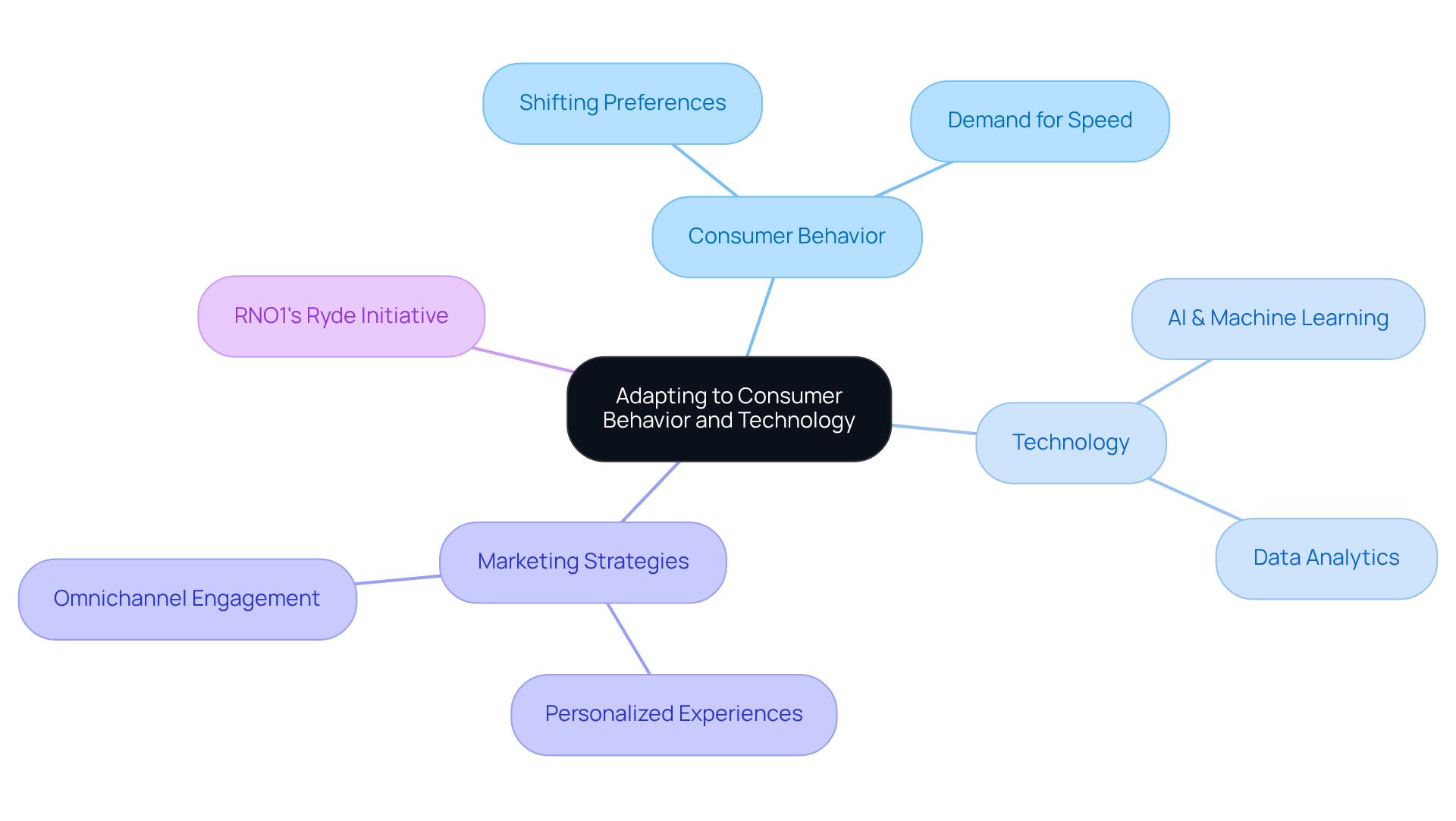Introduction
In a world where tech startups strive to stand out amidst a flood of marketing messages, the difference between inbound and outbound marketing has never felt more crucial. Many founders find themselves wrestling with the challenge of not just drawing in customers but also nurturing connections that last beyond that first interaction. This article explores the powerful potential of blending both strategies, showing how a balanced approach can pave the way for sustainable growth and deeper relationships with clients. As the marketplace shifts and evolves, one important question lingers: how can startups navigate the intricate landscape of consumer behavior and technology to truly enhance their marketing efforts?
Define Inbound and Outbound Marketing
Many tech startup founders face a common challenge in attracting clients in a crowded marketplace through effective marketing inbound and outbound. It can feel overwhelming, especially when traditional advertising methods seem to fall flat. You might find yourself pouring resources into TV commercials or cold calls, only to realize that these approaches often miss the mark when it comes to building genuine relationships with potential customers.
This is where the pain points become clear. Outbound promotion, while familiar, often leads to lower engagement rates in the context of marketing inbound and outbound. In fact, statistics from 2025 show that only 12% of professionals see a higher return on investment with these methods compared to marketing inbound and outbound strategies. It’s disheartening to think about the time and effort spent without the meaningful connections that truly matter.
But there’s hope. Inbound promotion offers a nurturing alternative, focusing on creating valuable content and personalized experiences that resonate with your audience. By crafting engaging materials - like insightful blogs, interactive social media posts, and effective SEO tactics - you can address customer needs and foster trust. It’s heartening to note that 82% of marketers who blog report a positive return on investment, showcasing the power of content-driven engagement in building lasting relationships.
As you navigate this competitive landscape, remember that understanding the differences in marketing inbound and outbound is crucial. Embracing inbound strategies not only enhances your promotional efforts but also aligns with the emotional needs of your audience. At RNO1, we’re here to support you in creating promotional strategies that not only attract clients but also nurture those vital connections.

Evaluate Pros and Cons of Inbound and Outbound Marketing
For many startups, the journey of lead generation can feel overwhelming. The struggle to find effective and affordable ways to attract customers is a common challenge. It’s disheartening to see high costs and low engagement rates, especially when trying to establish a foothold in the market. Outbound promotion might seem like a quick fix, offering instant visibility, but it often comes with a hefty price tag and can feel intrusive to potential customers. In fact, only 11% of marketers believe that paid media is the most effective method for generating leads. This can leave many founders feeling frustrated and unsure of their next steps.
But there’s hope. Inbound promotion offers a nurturing alternative that not only reduces costs but also builds lasting relationships with customers. By creating engaging content that truly resonates with their audience, startups can cultivate a loyal customer base. Companies that focus on inbound strategies often see an impressive 80% decrease in cost per lead after just five months of consistent effort. This approach is not only more sustainable but also significantly less expensive-61% less than outbound leads, to be precise.
As Khalid Saleh wisely points out, "incoming practices generate 54% more leads than conventional outbound methods." This highlights the effectiveness of inbound strategies in fostering genuine connections with potential customers. By understanding the advantages and disadvantages of both approaches, new businesses can tailor their marketing inbound and outbound strategies to fit their unique needs. It’s about finding that balance between the desire for quick results and the long-term benefits of attracting customers through meaningful engagement.
So, if you’re feeling the weight of these challenges, remember that you’re not alone. Embracing inbound promotion could be the supportive solution you need to thrive in today’s competitive landscape.

Integrate Inbound and Outbound Marketing Strategies
For many tech startups, the challenge of effectively reaching potential customers can feel overwhelming. You might find yourself pouring resources into marketing inbound and outbound strategies, such as targeted ads or cold outreach, only to wonder if they’re truly making an impact. It’s a common struggle, and it can lead to frustration when immediate results don’t materialize. But what if there was a way to not only capture attention quickly but also nurture lasting relationships with your audience?
Imagine combining those outbound efforts with engaging content like informative blog posts, eBooks, or webinars in a strategy focused on marketing inbound and outbound. This dual approach doesn’t just create prompt awareness; it fosters trust and loyalty over time. By sharing valuable insights and knowledge, you’re not just selling a product; you’re building a community around your brand.
Data analytics play a crucial role in this journey. They allow you to monitor how well both strategies are performing. By diving into metrics like engagement rates and conversion statistics, you can refine your tactics and truly understand what resonates with your audience. A unified promotional strategy that blends marketing inbound and outbound efforts empowers you to adapt to market trends and consumer preferences, paving the way for sustainable growth.
Successful case studies highlight the effectiveness of this integrated approach. Companies like HubSpot have shown that a well-executed dual strategy can significantly boost lead generation and enhance customer retention. As one industry leader put it, "Inbound strategies allow you to connect with a broader audience that has qualified themselves if you are producing well-targeted content." This underscores the importance of attracting pre-qualified leads through your internal efforts while employing marketing inbound and outbound to reach new audiences.
Moreover, consider this: 90% of people trust their peers on social networks, while only 15-18% trust brands. This statistic emphasizes the necessity of building relationships through inbound marketing. It’s about enhancing credibility and trust among potential customers. By embracing marketing inbound and outbound strategies, you can position your tech company for success in a competitive landscape, creating a nurturing environment where your audience feels valued and understood.

Adapt to Changing Consumer Behavior and Technology
In today’s fast-paced digital world, many tech startup founders find themselves grappling with the challenge of understanding shifting consumer behaviors. It’s a tough landscape, where technological advancements and changing preferences can feel overwhelming. You’re not alone in this struggle; many are feeling the pressure to engage their audience effectively amidst these rapid changes.
The rise of social media and mobile technology has reshaped how brands interact with consumers. It’s no longer just about getting your message out there; it’s about creating a personalized and responsive experience that truly resonates. RNO1's Ryde initiative stands out as a beacon of hope, showcasing innovative ways to scale omnichannel brand ambassador programs. These programs can significantly enhance e-commerce engagement through meaningful influencer partnerships.
By tapping into data analytics and consumer insights, startups like yours can refine their promotional strategies through marketing inbound and outbound, ensuring they align with current trends. Imagine being able to deliver targeted content and customized experiences that speak directly to your audience’s needs. With the integration of technologies like AI and machine learning, this isn’t just a dream; it’s an achievable reality. This adaptability isn’t just beneficial; it’s essential for long-term success in a competitive marketplace.
Consider this: the top-ranking organic result on Google enjoys an average click-through rate of 27.6%. This statistic highlights just how crucial visibility and relevance are in your marketing strategies. As mobile commerce continues to expand, it’s vital for new ventures to prioritize seamless, user-friendly experiences that meet consumer expectations. In fact, 82% of consumers are more likely to purchase from a retailer that offers same-day delivery. This underscores the growing demand for speed and convenience in today’s market.
By embracing these technological tools and insights, along with RNO1's results-driven approach-which includes developing content for national campaigns and executing user-generated content programs-you can navigate the complexities of modern consumer behavior with confidence. Together, we can drive engagement and foster a deeper connection with your audience.

Conclusion
Navigating the complexities of marketing can feel overwhelming for tech startups striving to thrive in a competitive landscape. It’s a challenge many founders face, and understanding the distinct roles of inbound and outbound marketing is crucial. Each strategy offers unique advantages that can significantly impact your startup's success. By leveraging the strengths of inbound marketing - like building trust through valuable content and personalized experiences - alongside the immediate visibility provided by outbound efforts, you can create a balanced approach that truly resonates with your target audience.
Consider the stark differences in engagement rates and cost-effectiveness between these two strategies. Statistics show that inbound methods can generate significantly more leads while reducing costs per lead. This insight highlights the importance of thoughtfully integrating both approaches to yield substantial benefits. Moreover, adapting to changing consumer behaviors and technological advancements is vital for maintaining relevance and fostering meaningful connections with potential customers.
Ultimately, embracing a dual strategy that combines the best of both worlds can position your tech startup for sustainable growth and success. By prioritizing relationship-building through inbound marketing while strategically employing outbound tactics, you can attract new clients and nurture long-lasting connections that drive loyalty and engagement. This holistic approach isn’t just a marketing tactic; it’s a pathway to establishing a brand that resonates deeply with your audience, paving the way for future innovation and success in an ever-evolving marketplace. Remember, you’re not alone in this journey - together, we can navigate these challenges and build a brighter future for your startup.
Frequently Asked Questions
What is the difference between inbound and outbound marketing?
Inbound marketing focuses on creating valuable content and personalized experiences that resonate with the audience, while outbound marketing typically involves traditional advertising methods like TV commercials and cold calls, which often lead to lower engagement rates.
Why do many tech startup founders struggle with marketing?
Many tech startup founders face challenges in attracting clients in a crowded marketplace, especially when traditional advertising methods seem ineffective and fail to build genuine relationships with potential customers.
What are the engagement rates for outbound marketing strategies?
Statistics from 2025 indicate that only 12% of professionals see a higher return on investment with outbound marketing methods compared to inbound strategies.
How does inbound marketing foster customer relationships?
Inbound marketing fosters customer relationships by creating engaging materials, such as insightful blogs, interactive social media posts, and effective SEO tactics, which address customer needs and build trust.
What is the return on investment for marketers who use blogging as part of their inbound strategy?
It is noted that 82% of marketers who blog report a positive return on investment, highlighting the effectiveness of content-driven engagement in building lasting customer relationships.
How can understanding inbound and outbound marketing benefit promotional efforts?
Understanding the differences between inbound and outbound marketing is crucial as it allows businesses to embrace inbound strategies, enhancing promotional efforts and aligning with the emotional needs of their audience.




